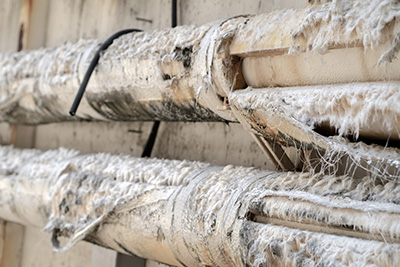Asbestos in Pipes: A Complete Guide
From the 1930s to the late 1970s, asbestos was widely used in both cement and steel pipes to make them more durable and resistant to fire, heat, chemicals and corrosion. Pipefitters, plumbers and others who worked directly with asbestos pipes during this time have a high risk of developing mesothelioma. Even today, workers and homeowners continue to encounter asbestos in pipes and insulation and should proceed with caution.
Use of Asbestos in Pipes
For decades, asbestos was used in many types of pipes throughout the United States. Cement asbestos pipes were more common and were used for plumbing in residential and commercial buildings and sewer lines. Cement asbestos pipes were also used to protect electrical and telecommunications wiring. Steel asbestos pipes were mainly used to move high-pressure liquids for industrial purposes.
While there isn’t a total asbestos ban in the U.S., the Environmental Protection Agency (EPA) did create strict regulations around its use, handling and disposal. Combined with growing consumer awareness, the use of these products mostly ended in the 1980s. However, building owners were not required to replace existing asbestos pipes, and there are many still in use today.
Asbestos Pipe Insulation

Asbestos was used in pipe insulation, also called pipe wrapping or lagging, because it was so resistant to heat, moisture and electricity. Asbestos-wrapped pipes were used often in boilers, water heaters, steam-heating pipes and cold-water pipes to prevent condensation.
Asbestos pipe insulation could be applied as a paper wrapping, mud-like plaster or spray. Certain types of paper insulation used in industrial applications even contained 100 percent asbestos. The EPA banned spray-on and prefabricated asbestos insulation in 1973, but before then, it was widely used in homes, factories, warehouses and ships.
Asbestos Pipe Connectors
Piping often needs to be formed around corners or in a network. It also needs to be airtight and watertight, but allow pressure to be released or materials to be removed at certain points. This requires connectors and other parts, including elbows, couplings, gaskets, valves and flanges, all of which could have contained asbestos before the 1980s. Because asbestos strengthened these parts and improved heat and chemical resistance, it was especially popular in connectors for pressurized and heated pipes.
Asbestos Pipe Adhesives
Asbestos was also very common in adhesives and sealants thanks to its durability and heat resistance. Asbestos pipe adhesives were used in boilers, chimneys, furnaces, kilns, manufacturing equipment and stoves, as well as heating and air conditioning systems. Any piping that required a strong seal, especially industrial applications, likely used asbestos adhesives.
Understanding Health Risks of Asbestos Pipe
Asbestos is a naturally occurring mineral made up of microscopic, long, thin fibers. When it’s damaged or disturbed, it releases these fibers into the air. If they’re not properly protected, people can inhale these fibers into their lungs, where they become trapped. Over time, scarring and inflammation build up around the fibers, and they can cause serious asbestos-related diseases, including mesothelioma, asbestosis and lung cancer.
Asbestos-wrapped pipes can be especially dangerous because the insulation is highly friable, which means that it can be easily disturbed. Older insulation can release asbestos fibers simply by touching it with your hand or from a small vibration, like a door closing.
How Are People Exposed to Asbestos Pipe?
Typically, asbestos products aren’t a health hazard unless they’re disturbed and release fibers into the air. But asbestos pipe is a unique situation because it carries water to our homes and is so easily friable, leading to two common ways people are exposed.
Drinking Water
One of the most common uses of asbestos pipes in the early 20th century was to transmit water to homes and businesses. While most local governments regulated its use in municipal water pipes by the 1950s, cities weren’t required to replace old pipes. Today, these pipes are ageing and breaking down, which could release asbestos into the water.
Under the Safe Drinking Water Act, asbestos is limited to 7 million fibers per liter (MFL). Yet as recently as 2017, the city of Arp, Texas found asbestos up to levels of 13 MFL. The city quickly replaced the asbestos pipes.
At-Risk Occupations
Workers who installed, repaired or worked around asbestos pipes, insulation or other parts before the 1980s are at a high risk for mesothelioma and other diseases. These pipes are also still an issue for many modern workers because they were never replaced and are now beginning to break down. The most at-risk occupations include:
- Boiler workers
- Building inspectors
- Carpenters
- Construction workers
- Electricians
- Engineers
- Factory workers
- Furnace workers
- Insulators
- Maintenance workers
- Millwrights
- Oil refinery workers
- Pipefitters
- Plumbers
- Shipyard workers
- Steamfitters
How to Tell If You Have Asbestos Pipes
It’s nearly impossible to tell if a cement or steel pipe contains asbestos just by looking at it. When it comes to insulation, asbestos-wrapped pipes may look stringy, fluffy or fabric-like, while plaster and spray insulation has an irregular, rough look.
Because it was so widely used in the 20th century, it’s safest to assume that any piping installed before the 1980s contains asbestos. Professional testing is the only way to be sure you have asbestos pipes. If you encounter pipes installed before 1980 that are crumbling, broken, fraying or damaged, especially if they’re exposed, call an expert to test for asbestos.
What to Do If You Have Asbestos Pipes
If testing reveals that you do have asbestos pipes, it’s best to leave it up to the professionals. There is no safe level of exposure to asbestos, and professional contractors will have the equipment and expertise needed to protect themselves and you. You should never drill, cut or work with asbestos pipes, insulation or other materials.
In some cases, you may be able to seal the asbestos pipes with another material or seal off the entire area of the wall to prevent the asbestos from being released into the air. This isn’t always practical, especially for drinking water pipes, but a licensed asbestos abatement contractor can help you figure out the best option for your situation.
Legal Options for Asbestos Pipe Exposure
Asbestos companies used this dangerous material in pipes and other products even after they knew it was a health hazard. If you’ve been exposed to asbestos pipes and were diagnosed with mesothelioma, you and your loved ones may be able to get compensation for your medical bills and pain and suffering.
With over 40 years of experience, Early, Lucarelli, Sweeney and Meisenkothen has secured nearly $5 billion in mesothelioma compensation for victims of asbestos exposure. Our wins in court include $13.5 million for a plumber in California and $12.2 million for an Ohio pipefitter. Contact us today to talk about your experience with asbestos pipes and how we can help.
FAQs
What are the health risks of asbestos pipe exposure?
Damaged asbestos pipes can release tiny fibers into the air that damage the lungs when they’re inhaled. This can lead to serious illnesses like mesothelioma, asbestosis and lung cancer. Anyone who worked or currently works directly with cement or steel pipes, pipe insulation or other parts, like gaskets and valves, is at the highest risk.
How can I protect myself from asbestos pipe exposure?
Workers in high-risk occupations should follow all asbestos guidelines, properly wear safety gear and change out of their clothing at the end of a shift to avoid bringing fibers into the home. Homeowners who suspect they may have asbestos pipes should contact a licensed asbestos professional to test and remove the pipes.
How do I identify asbestos pipe insulation?
Insulation on asbestos-wrapped pipes may look and feel like paper or fabric. If it’s degrading, it may appear stringy or corrugated. Spray-on and plaster asbestos pipe insulation may look like cement, with a rough, irregular and hard surface. However, the only way to know for sure if insulation has asbestos is to test it.
Is it safe to remove asbestos pipe insulation on my own?
No, it’s generally not recommended that homeowners remove any asbestos materials themselves. Pipe insulation is very friable, meaning it’s extremely easy to release the fibers into the air where they can be inhaled. Always call a licensed asbestos abatement contractor to test and remove asbestos.
Request a Free Case Evaluation
Request a free case evaluation now if you or someone you love has been diagnosed with mesothelioma. The evaluation will cost you nothing. Our lawyers will travel to visit you at your convenience or conference call with you over the phone. We understand how difficult a time this is for you and will assist in any way that we can. You can also call us toll-free at 1-800-336-0086 at any time.

Results
The jury awards and settlements we have received for our clients are among the highest in the country.
Occupation/Exposure
Mechanic
Age
66
State
WA
Results
~$102,200,000
Occupation/Exposure
Cosmetic Talc User
Age
75
State
AZ
Results
~$22,200,000
Occupation/Exposure
Talc Powder User
Age
59
State
UT
Results
~$20,000,000
Occupation/Exposure
Home Renovator
Age
75
State
RI
Results
~$15,100,000
Occupation/Exposure
Electrician
Age
62
State
NV
Results
~$13,800,000
Occupation/Exposure
Plumber
Age
49
State
CA
Results
~$13,500,000
Occupation/Exposure
Abatement Worker
Age
70
State
CT
Results
~$12,600,000
Occupation/Exposure
Pipefitter
Age
58
State
OH
Results
~$12,200,000
Occupation/Exposure
Pipefitter
Age
65
State
NV
Results
~$12,000,000
Occupation/Exposure
Navy Veteran
Age
48
State
CA
Results
~$11,700,000
Occupation/Exposure
Air Force Veteran
Age
84
State
KY
Results
~$11,700,000
Occupation/Exposure
Hairdresser
Age
66
State
MD
Results
~$11,500,000
